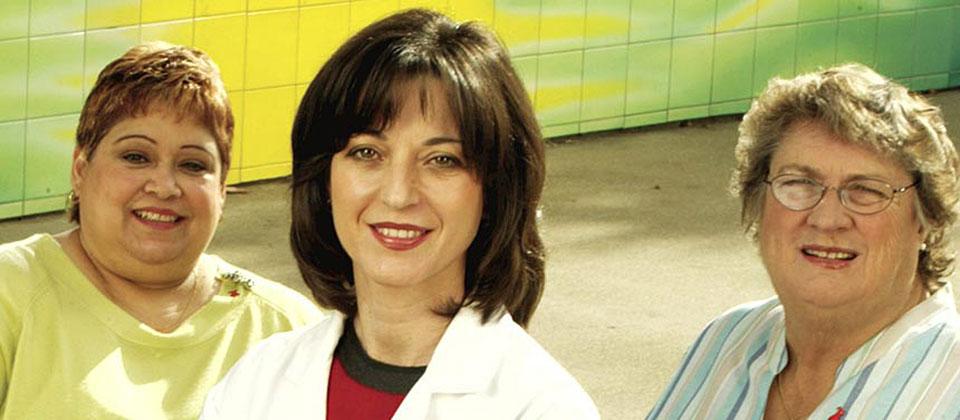
Amparo Villablanca, M.D.
More information
Professor, Frances Lazda Endowed Chair and Director of Women‚Äôs Cardiovascular Medicine, ¬„¡ƒ÷±≤• School of Medicine
Shortly after completing her training to become a cardiologist, Amparo Villablanca learned cardiovascular disease was the leading killer of women, with death rates far outpacing those in men—two facts the medical community had yet to fully recognize.
Villablanca dealt with the challenge the way she always has tackled problems during nearly four decades as a physician-scientist at ¬„¡ƒ÷±≤• Health: finding an innovative solution. In this case, it meant becoming a champion and pioneer of women‚Äôs heart health by developing the first women‚Äôs heart program in the country.
Villablanca is a product of the UC system, completing her undergraduate work at UCLA and graduating from the ¬„¡ƒ÷±≤• School of Medicine in 1983. She also completed her internal residency and fellowship in cardiovascular medicine here. She selected the School of Medicine for its commitment to primary care and the opportunity for professional growth, and chose cardiovascular medicine in order to work in a challenging discipline rife with opportunities for prevention, cutting-edge research, critical care and teaching. Additionally, she wanted to devote her career to biomedical science because of the potential for innovation and creativity that, coupled with medicine, could allow her to have a greater impact on patient health‚Äîwhether she‚Äôs conducting experiments to answer basic research questions, developing models of care that empower community members to improve their health, or supporting women in advancing their biomedical science careers.
A pioneer in the field
In 1994, Villablanca launched the ¬„¡ƒ÷±≤• Women‚Äôs Cardiovascular Medicine Program. It was the country‚Äôs first women-centered heart program, unbeknownst to her at the time. ‚ÄúWe had to do something big‚Äîas impactful as possible‚Äîand sustainable,‚Äù she says.
Villablanca was responding in part to a dearth of understanding of gender differences in heart disease and a lack of women participants in clinical studies. Women were being underdiagnosed and undertreated, and the field was underfunded. “It’s still the case,” she says. “The leading killer in the whole country is something that only about half of women are aware of and only about 20 percent of health professionals say they feel comfortable managing. We’ve made progress with deaths in women declining, but there is still much more progress to be made.”
The award-winning program has four pillars. It raises awareness about the different types of cardiovascular disease in women; educates women, health professionals and community members about heart disease and its prevention; provides state-of-the-art clinical services for women with heart disease or those at risk of developing it; and conducts research that seeks to close gaps in scientific understanding of gender differences in the disease.
Villablanca also seeks to understand the interplay between race and ethnicity and cardiovascular disease in men and women. It is “one of the reasons that I’ve focused my work on high-risk groups, which are racial and ethnic minority women,” she says. “They are highest risk and have the worst outcomes from heart disease.”
A champion of women in STEM careers
In 2000, Villablanca began promoting women’s medical and health science careers on an institutional level. The medical school nominated her for a competitive fellowship with Executive Leadership in Academic Medicine, a national leadership training program for women faculty. As part of her project, she established programs in medicine, diversity, mentoring and faculty development that continue to thrive today.
The fellowship assigned her a mentor, School of Medicine pathology department chair Lydia Howell, who had just completed the program. “We continue to work together and collaborate to make a difference in women’s careers,” Villablanca says. “Dr. Howell started off as a mentor and has become a wonderful friend and collaborator.”
Also in 2000, the pair co-founded the School of Medicine’s Women in Medicine and Health Sciences program, which she and Howell continued to shepherd until it became institutionalized two years ago. Villablanca was its founding director until January 2018.
The program’s goal is to help women with careers in the academic health sciences realize their full academic potential. It provides mentoring, networking and leadership opportunities, and celebrates women’s professional successes. When the program started, 17 percent of the medical school’s faculty were women. Today, that number has more than doubled.
“To understand why we have the program, you have to recognize that women’s advancement through academia is not the same as men’s,” Villablanca says. “There is a huge attrition of women out of the advancement pipeline.”
A new chapter in leadership
Villablanca is developing a new venture that kicked off July 1. The Office for Advancing Leadership Across the Health Sciences, which she directs, will serve as a leadership innovation hub for medical trainees and faculty in the health schools. The program’s goals are boosting performance and retention, enhancing professionalism and collegiality, creating a culture of opportunity and effecting positive cultural change.
“Leadership requires expertise different from other academic roles, and many faculty aspire to leadership positions but do not have a leadership mentor and sponsor, do not receive leadership training and may not have the skills needed,” she says.
“By advancing leadership opportunities and training for all faculty, including those with critical needs such as women and underrepresented minorities, we advance the excellence and diversity that is so vital to achieving our academic mission.”
Learn more about